|
Although the visual examination of coarseware and fineware sherds did
not prove conclusive, the chi-sqarue test gave us the statistic that
there is somewhere between a 5% and a 2% probability that the two areas
had similar functions, based upon the ceramic assemblages.
This is an extremely low figure which can be taken to strengthen Professor
Biddle's reasoning that the building excavated in Area 11, functioned
differently to that of a 'typical' Seacourt house as represented by
Area 4. This statistic, although not proving the existence of
an inn, provides mathematical justification for further study.
However,
the results may also be misleading. Rather than strengthening our argument
about the function of these buildings, the results may simply reflect
the level of 'brokenness' of the vessels. More detailed recording is
needed to eliminate this possibility, a requirement which the four week
time limit for this study would not allow.
In
answer to the general question, 'Is it worthwhile re-examining sites
such as Seacourt?', this case-study has undeniably highlighted the
fact that there is far more information that can be obtained by looking
at the excavated material once again.
|
|
Figure
6.
Photograph
showing the excavations of Seacourt, source: Biddle, 1963.

General view looking north of the 1958 excavations on the East
side of the former Botley / Wytham road. Area 4 is in the middle
distance, with Area 5 beyond.
|
|
|
With modern scientific methods employed, such as residue analysis or
thin-section fabric analysis for example, a greater insight as to the
function of ceramics from such sites could be obtained. Coupled with
modern dating techniques and a greater time limit, this study shows
that there is unquestionable potential to greatly enhance the picture,
first outlined by Professor Martin Biddle in 1963.
|


